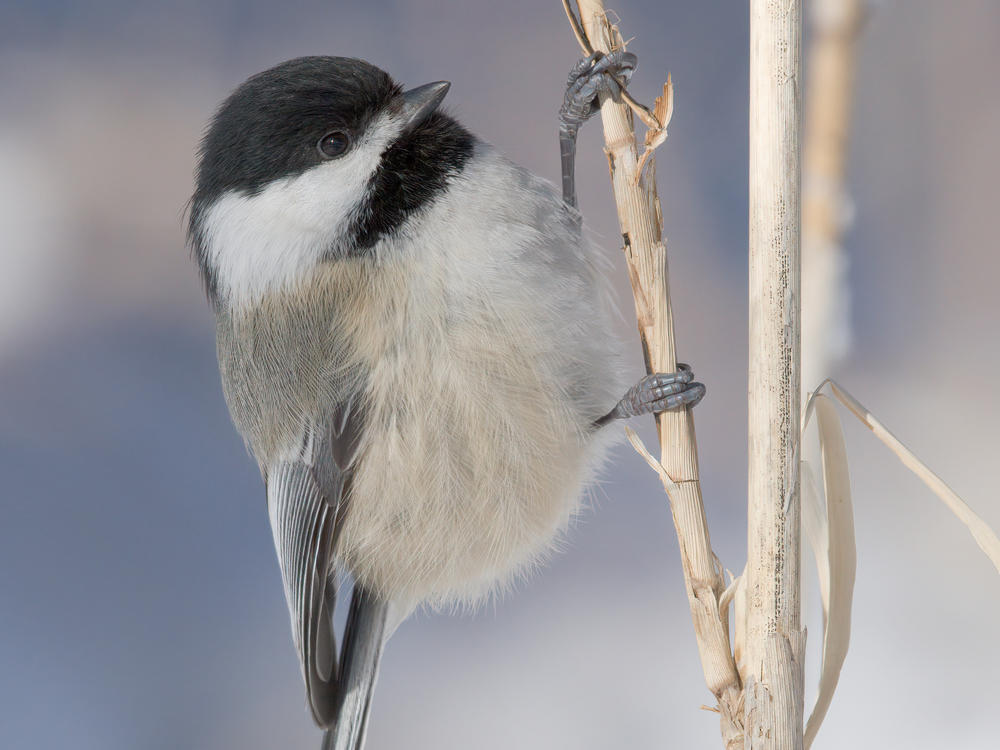Section Branding
Header Content
The "barcodes" powering these tiny songbirds' memories may also help human memory
Primary Content
Tiny, black-capped chickadees have big memories. They stash food in hundreds to thousands of different locations in the wild – and then come back to these stashes when other food sources are low. Now researchers at Columbia University's Zuckerman Institute think unique patterns of neural activity that work like barcodes may be to thank for this impressive feat. Their work was recently published in the journal Cell.
Scientists have known that chickadees possess incredible memory skills. That memory can be a matter of life or death for these birds as food sources dwindle in colder months.
The hippocampus is critical to the formation of these types of memories. Colin Saldanha, a songbird researcher and neuroscientist at American University unaffiliated with the study, says that the hippocampus in these birds' brains even expands in chickadees' brains as they gather and store seeds each fall. Saldanha is unaffiliated with the study.
"These animals show a level of plasticity in their brains that puts us humans to shame," he says.
Unique brain activity for different memories
Some researchers thought that neurons called "place cells" would explain these birds' ability to remember where their food is stashed. These cells are known to encode information about where things are in space. But recently, a team of researchers found that each time a chickadee hides a seed in a specific location, a unique brain pattern appears in the hippocampus – separate from place cells. Selmaan Chettih likened it to a barcode.
"The hippocampus sort of flipped states," Chettih says. "It was like a switch flipped. And now there was this totally new pattern of activity that was really distinct from the place cells."
To observe this, Chettih and his team built arenas with sunflower seed-filled feeders in the corners. Wooden perches for the birds were scattered throughout, with small flaps where birds could hide seeds.
The scientists inserted tiny probes in the chickadees' brains and tracked activity in their hippocampuses. Each time a bird hid a seed under a flap, researchers saw a brief, unique brain pattern appear – what they called the "barcode." Each pattern was specific to an instance of seed-hiding, so different patterns appeared even when the birds hid multiple seeds in the same location or when stashes were created at neighboring perches.
When the birds revisited these sites and retrieved the hidden seeds, the same barcode-like pattern popped up again, as though all the information about each location and seed were associated with a unique brain pattern.
Our memories define us. But what do they look like?
The researchers compared these memories to episodic memories in humans, which are memories of specific events or personal experiences. They're essential to how humans define themselves and bind together moments in time, people, places and sensory information. But the mechanism for how this binding happens is still unclear.
Chettih says it's incredibly difficult to know exactly when an animal is forming a memory. So the fact that this seed-hiding behavior has a clear pattern of activity associated with it may help researchers build a framework for how the brain creates and stores memories.
Saldanha says this is what makes the study "truly heroic" — it allows researchers to see a memory in the brain as it is being made. "They're almost relying on the animal's own talents in order to understand ... the neural basis of this remarkable behavior," he says.
Listen to Short Wave on Spotify, Apple Podcasts and Google Podcasts.
Listen to every episode of Short Wave sponsor-free and support our work at NPR by signing up for Short Wave+ at plus.npr.org/shortwave.
Today's episode was produced by Berly McCoy and Vincent Acovino. It was edited by Rebecca Ramirez, Viet Le and Christopher Intagliata. Rachel Carlson, Rebecca and Regina G. Barber checked the facts. Valentina Rodriguez-Sanchez and Patrick Murray were the audio engineers.
Bottom Content

